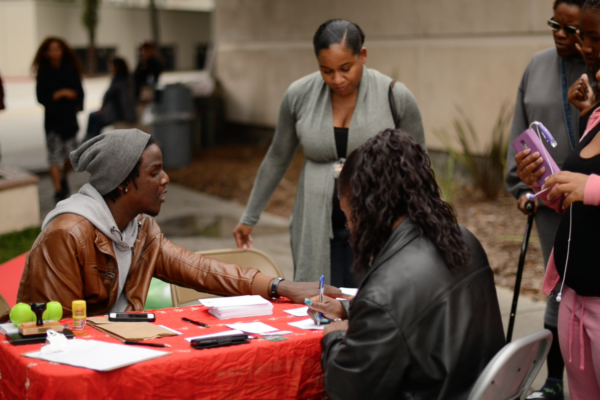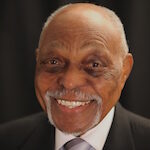This post originally appeared on the Sunday OpEd page of the L.A. Times.
I participated in the civil rights movement in the 1960s. I was pastor of my second church, in Kansas City, Kansas, in 1968. A decade later, I began my nearly 30-year tenure at the First African Methodist Episcopal Church in Los Angeles. I saw the courage and the chaos of those times, and what happened next.
When I compare the civil rights era with the Black Lives Matter era, one sure sign of progress stands out: We have a black president. And yet as President Obama’s second term draws to a close, every week seems to bring another video, an addition to the toll of unarmed black men killed by police violence, and now the deaths of police officers too. Will violence, especially racial violence, never end?
In Los Angeles, we measure change in the black community by looking first at some specific flashpoints: The Watts riots of 1965 and the Rodney King riots of 1992. Watts revealed, in part, the deep divide between police and the black community; 1992 showed how little the demands and the warnings of 1965 were heeded.
The 1992 civil unrest was more destructive than any other uprising in our nation’s history: More than 60 dead by the Los Angeles Times’ count, 2,000 wounded, thousands arrested, a billion dollars in property damage. The King beating also brought about immense changes in policing in Los Angeles: the Christopher Commission, an inspector general, and later the federal consent decree. The prejudiced practices of the Los Angeles Police Department of William Parker and Daryl Gates were replaced with real, if still to be perfected, reforms made by our last four police chiefs.
But now, as then, too many young men of color are being killed by police and getting locked up in Los Angeles and the rest of America.
Starting in the late 1970s and 1980s, America led the world in prison construction and confinement. Now 2.2 million Americans are incarcerated, more than in any other nation. According to the National Assn. for the Advancement of Colored People, nearly half the prison population is African American, and black men are nearly six times as likely to be incarcerated as white men. Drug-related offenses play a big role in incarceration; blacks represent 12% of drug users but 32% of those arrested for possession.
We’ve cut the incarceration rate among juveniles in half since 1999, but the system remains much harsher toward youngsters of color. Data gathered by the Youth First Initiative shows that youngsters of all races commit crimes at about the same rate, but black youth are five times more likely to be incarcerated than whites.
In recent years, court orders and legislation have taken aim at mass incarceration. In 2010, the U.S. Supreme Court ruled that California’s overcrowded prisons defied the Constitution, which prohibits inhumane treatment. In 2014, Californians voted for Proposition 47, reducing six categories of non-violent crimes, including drug use, to misdemeanors.
As the imprisoned population drops because of Proposition 47, the money saved — which should total about $150 million a year by some estimates — is supposed to go to crime prevention and rehabilitation: mental health counseling, substance abuse treatment, job training and housing. This year, Gov. Jerry Brown says only $29 million will be available for such purposes. His figures are disputed; what is certain is that more than $29 million is needed to fight recidivism.
Even so, after years of filling cells, we’ve at least begun to recognize the need for criminal justice reform. We know that privatization of prisons creates incentives to maximize confinement and that punishment needs to be tempered with rehabilitation.
In the 1960s and 1970s, we talked about poverty, not homelessness. President Lyndon Johnson declared a War on Poverty. It helped, but now California leads the U.S. in chronic homelessness, and Los Angeles leads California — 47,000 men, women and children (at last count) are sleeping on our streets, under our freeway bridges, and in our shelters. The president’s outreach, combined with efforts by the Los Angeles County Board of Supervisors and the City Council, brought down the number of homeless veterans in L.A. Will city and county officials, and the voters, do what’s required to solve the problem?
In 1964 and 1965, blacks won two massive legislative victories: passage of the Civil Rights Act and the Voting Rights Act, both historic victories for the cause of equality. But just a few years later — in 1968 — the symbol of the movement that won those rights, Martin Luther King Jr., was assassinated. And a half-century after our voting rights were secured, our jaws dropped when the Supreme Court turned voting regulations back to states that had long discriminated; we’ve had to battle new voter restrictions in more than a dozen states.
Looking back, I know much has been accomplished. Looking forward, I know much more must be done. There is, at least, no hiding place anymore for racism. No longer would we tolerate an Alabama governor saying (as George Wallace did in 1963), “Segregation now, segregation tomorrow, segregation forever.” In Internet postings that shock us and sadden us, we see the latest inequities with our own eyes.
Some say we live in a post-racial, post-civil rights era. I say the era of civil rights isn’t over. Like 1968, 2016 will be a decisive year. What future will we choose, Angelenos?
Cecil Murray is retired from the USC Center for Religion and Civic Culture.





